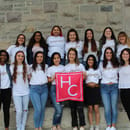From smartphones to refrigerators, to cars and lightbulbs, there are a number of significant inventions that we use in our everyday lives. We know the names of many famous modern inventors and entrepreneurs, such as Bill Gates, Steve Jobs, and Elon Musk. What they all have in common, besides making our lives easier and more efficient, is that they are white men. What about the inventors and entrepreneurs that identify as women? What about the inventors and entrepreneurs that happen to be marginalized, indigenous peoples, or people of color? They don’t get nearly enough credit and attention for their contributions to society. In honor of Black History Month, here are five black women and the things they helped to invent.
- Mary Beatrice Davidson Kenner – A better menstrual pad
-
Mary Davidson Kenner and her sister Mildred Davidson were two women inventors in the 1950s. Despite not having a formal education, the pair patented several inventions in their lifetimes. In 1956, with the help of her sister, Mary improved upon the existing design of the menstrual pad. She coined it “the sanitary belt” in which she added a moisture-resistant pocket to prevent messes and leakage. Later in her life, Mary became diagnosed with multiple sclerosis (MS) and began to use a walker. She went on to patent both a tray and pocket that was attached to the walker, helping to improve the lives of those who used them. Today, Mary continues to hold the record for the greatest number of patents granted to a black woman by the U.S. government!
- Marie Van Brittan Brown – Home security system
-
In 1966, Marie Brown developed her very own security system to monitor her house in Queens, New York. When Marie’s husband was away for work, she often felt unsafe due to high crime rates and unreliable police force in her neighborhood. She took it upon herself to invent a protective device. Her security system was very sophisticated and included a microphone, a camera to look through her peepholes, a button to unlock her door, and a button to call the police if need be. Marie also had a monitor inside her home that connected to the security camera. She applied for a patent that same year, but she wouldn’t be granted one for her brilliant work until 1969. Marie’s significant invention helped pave the way for many surveillance and security systems we use today.
- Sarah Elisabeth Goode – Folding bed
-
Sarah Goode was both an entrepreneur and inventor born into slavery in 1855. She is one of the first African-American women to receive a patent from the U.S. government. Nearly 30 years later, on July 14th, 1885, Sarah was granted a patent for her very own folding cabinet bed. During this post Civil War era, many African-American families lived in small homes and apartments with limited space. Sarah created a genius space-saving solution—a bed that, when not in use, could fold back into a desk complete with drawers and compartments. Modern folding beds, such as Murphy beds, use the same mechanism and closely resemble Sarah’s clever invention.
- Lyda D. Newman – Hairbrush
-
Lyda Newman was only 13 years old when she invented a new and improved hairbrush specifically for African-American hair. As a young girl, Lyda moved to New York and began a career as a hairdresser. She wanted a more efficient tool to help her work on clients’ hairs, so she created a dynamic hairbrush. She was granted a patent for her work in 1898. Lyda’s new design included synthetic bristles which were more durable, firmer, and didn’t break on coarse or thick hair. It also included an easily removable compartment used to collect dirt and dandruff. The truly unique feature of Lyda’s hairbrush was a chamber that allowed increased airflow to dry the hair quicker. Lyda’s improvements and improvisations actually made the brushes cheaper to manufacture, thus increasing accessibility to quality hair products for all women! Lyda was a brilliant, young entrepreneur who designed a hair product specifically for African-American women.
- Madam C.J. Walker – Hair products
-
Lastly, Madam C.J. Walker—born Sarah Breedlove—was the first black woman to become a self-made millionaire in America. You’ve probably heard of her. Madam Walker had a difficult upbringing and grappled with poverty in her early life. Attempting to find her way out, she moved to Illinois in 1889 and began working as a cook and laundress. Sarah was tired, overworked, financially drained, and losing her hair on top of it all. She began using “The Great Wonderful Hair Grower” produced by a prominent black businesswoman, Annie Turbo Malone. Amazed by the results from Annie’s products, Sarah joined her team and began selling the hair grower. Shortly after, Sarah married Charles Walker, renamed herself “Madam C.J. Walker,” and the couple moved to Colorado. She then curated her own line of hair care products and hair straighteners, and her most notable invention being “Madam Walker’s Wonderful Hair Grower.” Her business grew exponentially and so did her wealth and reputation. Madam Walker’s influence was extensive, making her a prominent philanthropist, activist, entrepreneur, and pioneer in her field. Plus, you can stream Self Made: Inspired by the Life of Madam C.J. Walker on Netflix, a limited series based on Madam Walker’s life.
Happy Black History Month!




